Creating an effective SEO strategy requires a lot of preliminary research and planning.
This actionable guide walks you through all the steps it takes.
But first, some basics.
How to Create an Effective SEO Strategy in 2024:
What Is an SEO Strategy?
An SEO strategy is a plan detailing what you’ll do to improve your website’s chances of appearing high in search results. Which can increase organic (unpaid) traffic to your website and even drive more conversions.
Your strategy documents your action plan, including the content you’ll create, optimize, and promote.
It also includes an assessment of your current performance, a competitive analysis, a site audit, and a link building strategy. All of which we’ll cover in more detail later on.
Tip: Create a free Semrush account to follow the steps in this guide
How to Create an SEO Strategy
1. Assess Your Current SEO Performance
Knowing your current SEO performance helps you see where you currently stand. And enables you to set strategic SEO goals.
For most sites, it makes sense to measure organic traffic, keyword rankings, and backlinks.
Organic Traffic
Organic traffic is the number of visits to your site that come from organic search. This doesn’t include traffic from paid search ads.
Google Analytics 4 (GA4) is helpful for analyzing website traffic. But you can quickly gauge your organic traffic with Semrush’s Domain Overview.
Here’s how:
Launch the tool and enter your domain (or subdomain or subfolder) into the search bar. And click “Search.”

You’ll come to the tool’s “Overview” tab, where you’ll see a high-level view of some of your website’s most important metrics, including “Organic Search Traffic”—which displays your monthly organic traffic for the current month.

You can also view a chart showing your organic traffic over time. Which you can adjust to display results for different time ranges.
Benchmark your organic traffic by determining the average amount of traffic you get in one month. So you know how much you need to improve.
Keyword Rankings
Keyword rankings are the positions where your website is displayed in search engine result pages (SERPs) for your target keyword.
Higher-ranking pages tend to get more organic traffic. So, aim to rank as highly as possible for relevant keywords.
Use Semrush’s Organic Research tool to benchmark your current rankings. It shows your positions for all keywords—not just those you already know you want to rank for.
In the “Overview” tab, you’ll see the total number of search terms you rank for. And a chart that displays your rankings over time.
Hover over the latest month to see a detailed breakdown. And consider how many terms are in positions No. 1 to No. 3—which are ones in good standing.
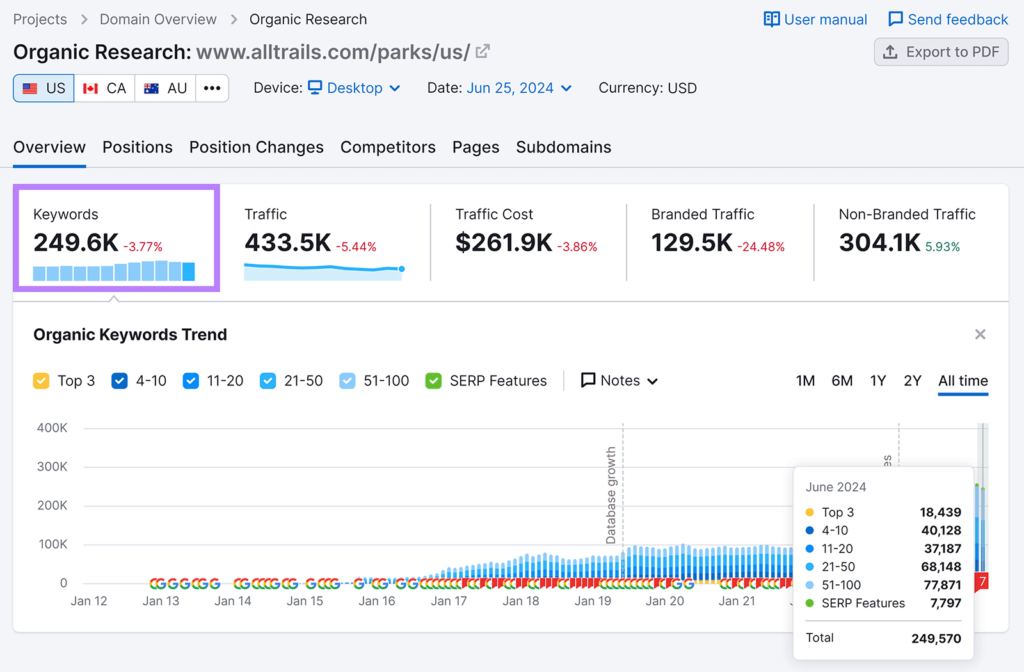
This company might aim to grow the overall number of rankings and also increase the number of keywords in positions 1 to 3.
For more detailed information, go to the “Positions” tab. Where you can view metrics for each term. Like your current ranking (“Position”), search intent (“Intent”), the total number of monthly searches (“Volume”), etc.
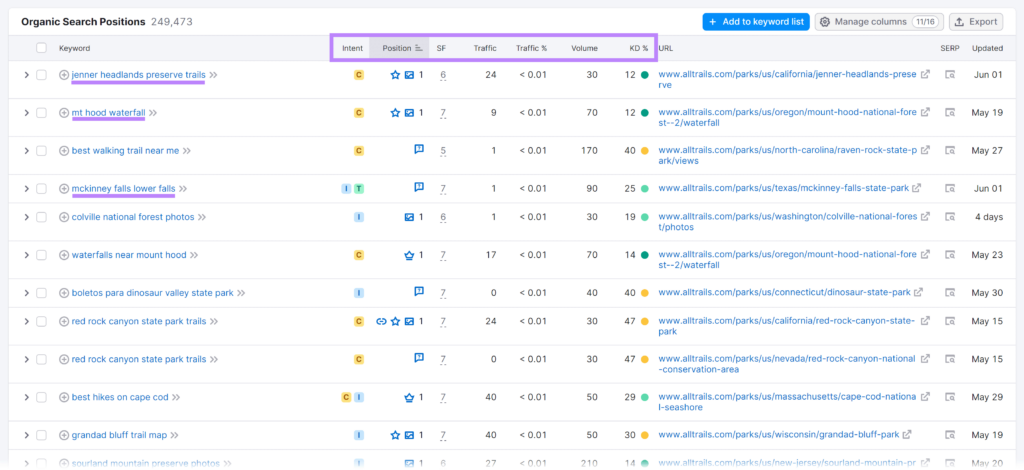
Backlinks
You can think of backlinks (links from other sites that point to your site) as votes of confidence that signal to search engines your site is reputable and worthy of showing in search results. Which can improve your rankings.
Semrush’s Backlink Analytics tool allows you to study your backlink profile to set a benchmark.
Here’s how:
Launch the tool and paste your domain, subdomain, or subfolder into the search bar. And click “Analyze.”

You’ll arrive at the “Overview” page. Which shows the number of websites that link back to you (Referring Domains”) and the total number of backlinks to your site (“Backlinks”).
You’ll also see your “Authority Score”—a measure of how reputable your site is.
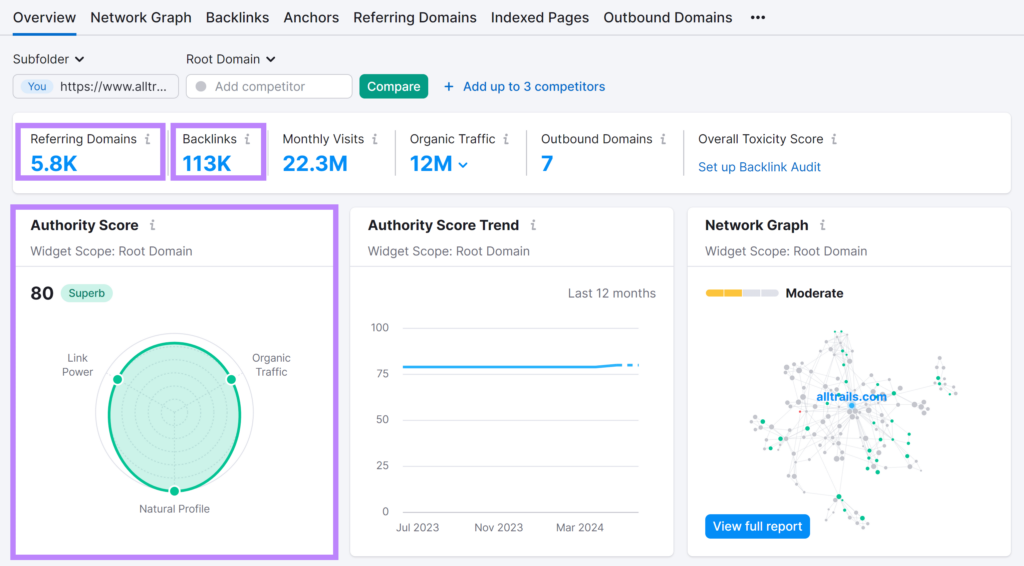
Now that you’ve established this and other benchmarks, you’ll need to understand which keywords you want to target.
2. Perform Keyword Research
Keyword research is the process of finding and selecting relevant search terms you want to rank for. It guides you in deciding what content to create.
Semrush’s Keyword Magic Tool lets you find new ranking opportunities by drawing on a database of over 25 billion search terms.
Simply type a seed keyword (a broad topic related to your niche) into the search bar and click “Search.”
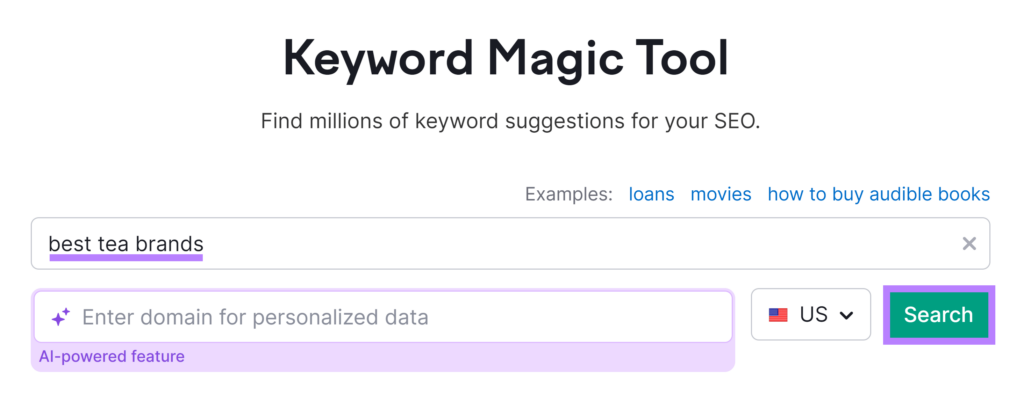
The tool will list potential keyword ideas based on the seed keyword. Which you can evaluate to find relevant terms.
For each term you’re interested in, consider its search volume and keyword difficulty (a percentage indicating how hard it will be to rank in the top 10 for a given keyword).
Ideally, you’ll want to focus on keywords with high volumes and low keyword difficulty scores. Because they have the potential to drive a lot of traffic and aren’t too difficult to rank for.
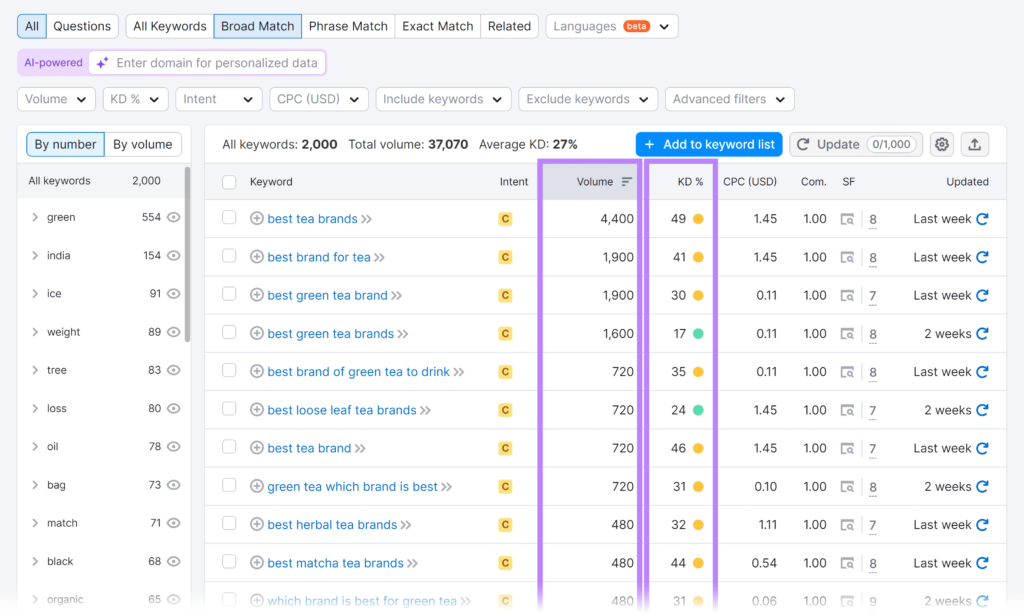
Next, select “Questions” in the top left corner of the screen to see related questions to get some more specific content ideas.
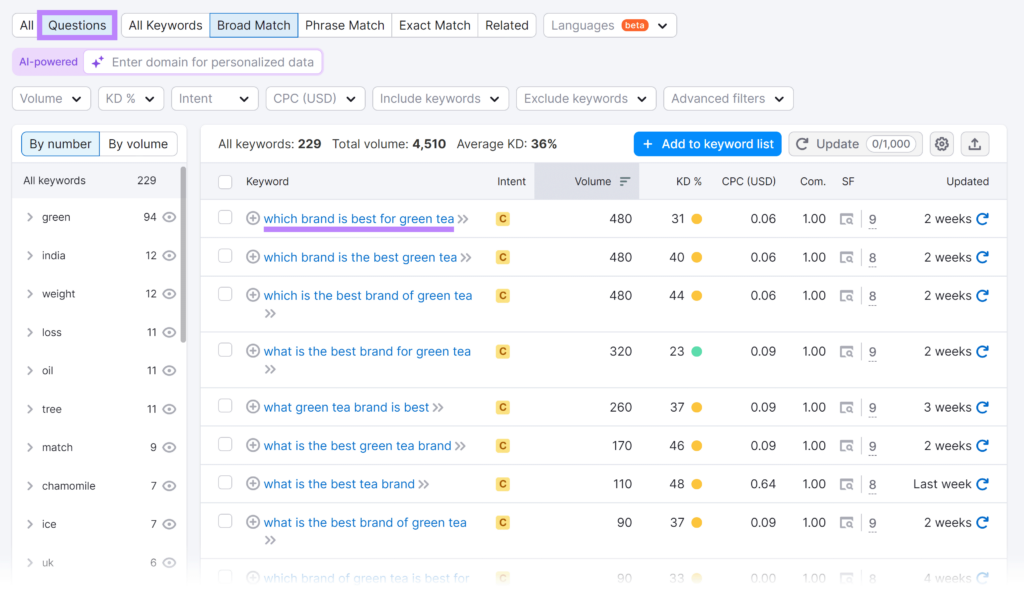
Make note of a few terms you want to target.
3. Analyze the Competition
A competitor analysis helps you see what’s already working for your rivals. So you can make informed decisions about your SEO strategy.
Start this process with Semrush’s Organic Research tool. To see keywords competitors are ranking for and their top pages.
Type in a competitor’s URL and click “Search.”
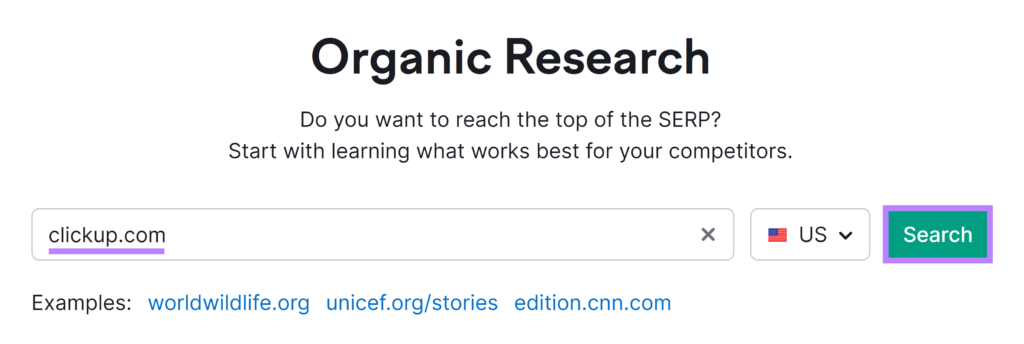
In the “Overview” tab, you’ll find high-level data like how many keywords your competitors rank for and their rankings for those terms.
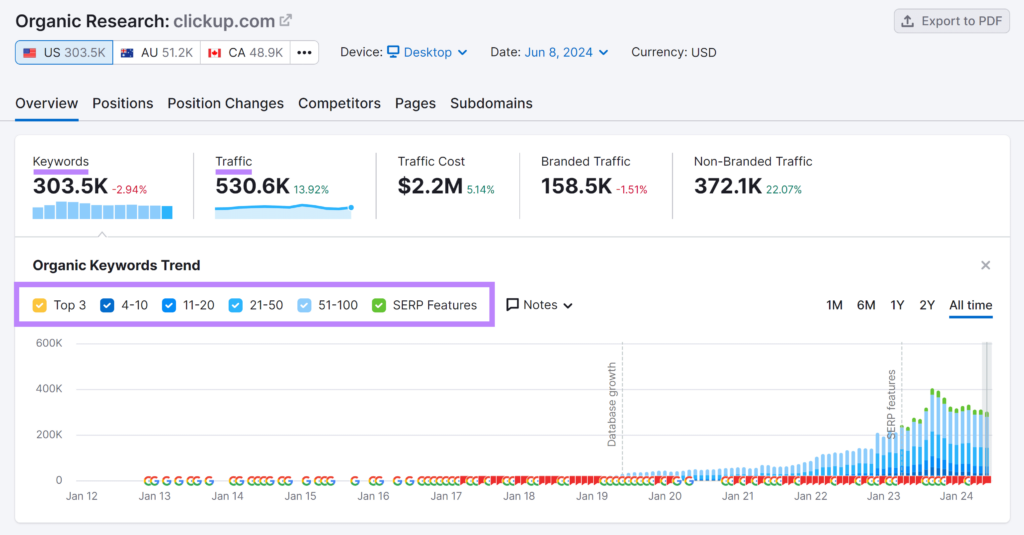
Go to the “Positions” tab to see the full list of keywords sorted by the percentage of traffic they send to your competitor’s site.
In this case, the keyword “clickup” drives 13.64% of traffic to ClickUp’s site.
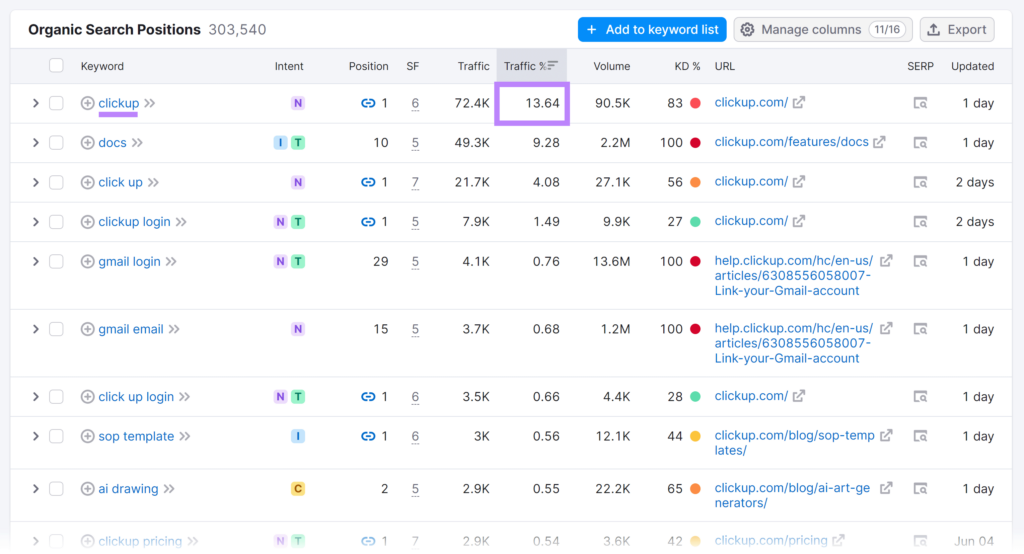
To find all the terms your competitor has No. 1 rankings for, click “Positions” and select “#1.”

You’ll likely find some valuable opportunities by doing this. Which you can add to the list you started earlier.
But you can find even more search terms worth targeting with Semrush’s Keyword Gap tool.
Enter your domain and up to four competitors’ domains and click “Compare.”
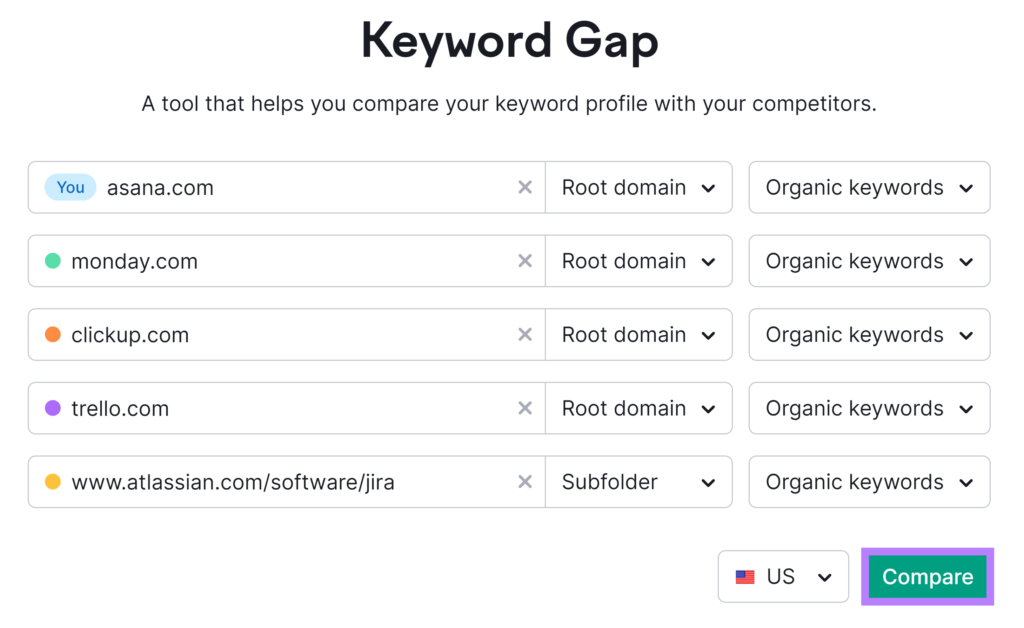
Scroll down the page to see a full list of keywords. You’ll see the keywords marked “Shared” automatically. These are keywords for which all of the domains you enter rank.
But you can also select the following categories:
- Missing: Keywords you don’t rank for but all your competitors do
- Weak: Keywords you rank for but your competitors rank better
- Strong: Keywords for which you outrank your competitors
- Untapped: Keywords you don’t rank for but at least one competitor does
- Unique: Keywords you rank for but none of your competitors do
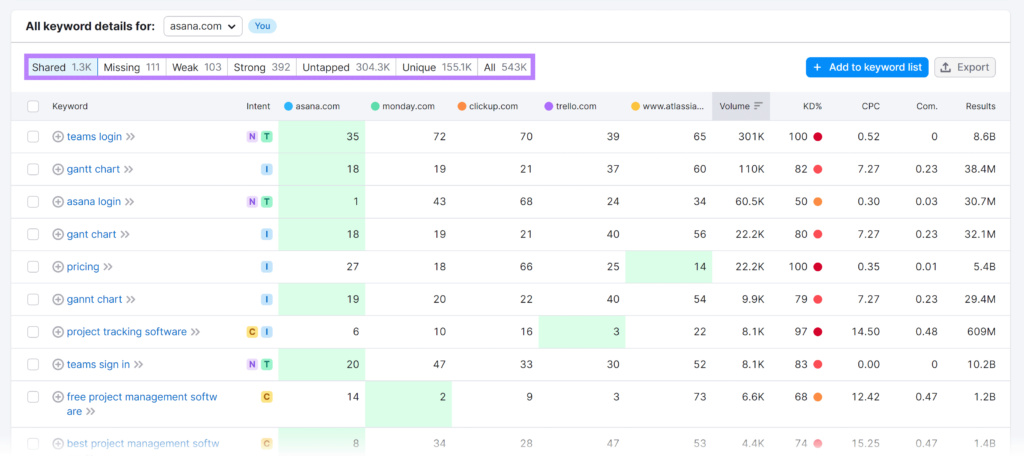
You’ll want to pay close attention to the keywords you’re “Missing” by clicking on that tab.
Jot down the keywords you discover to use later on.
4. Set Goals
Setting SEO goals will also help you decide which key performance indicators (KPIs) will define your success and help you assess your progress.
For example, let’s say your goal is to double the amount of organic search traffic you get in the next year. To support your company’s larger goal of increasing leads by 15%.
To increase your traffic from organic search, you need to improve your keyword rankings. And gaining quality backlinks is one of the best ways to improve your SEO performance.
So, you choose organic traffic, keyword rankings, and backlinks as your SEO KPIs.
Your KPIs will depend on your goals, but here are 12 examples of SEO KPIs to consider:
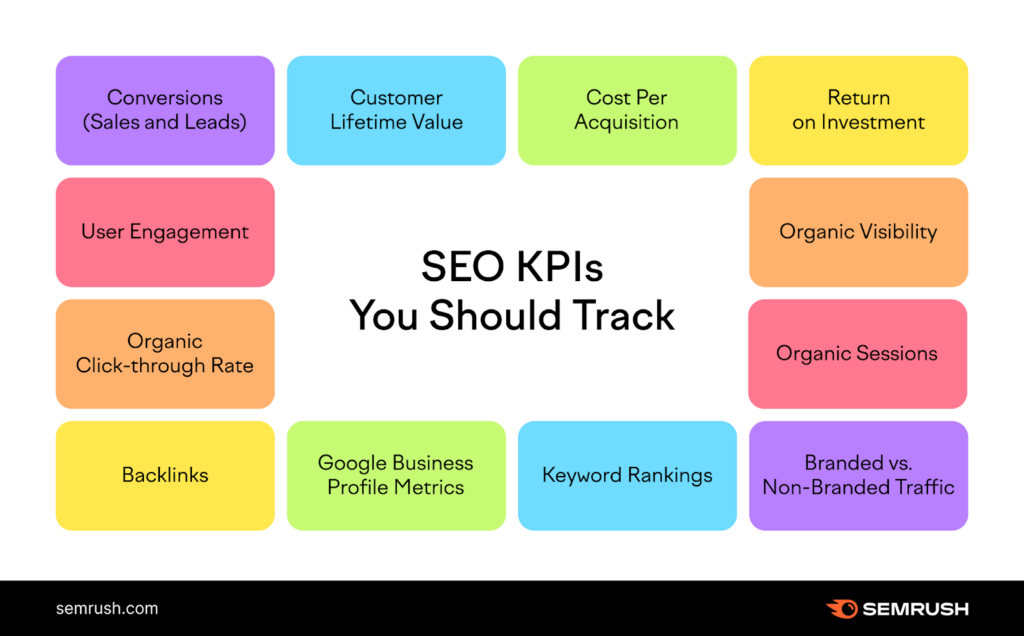
5. Audit Your Site
Auditing your website helps you find areas to improve. And there are three main ways to audit your site:
Technical Audit
Use Semrush’s Site Audit tool to uncover technical SEO and on-page issues that you can address to improve your chances of success.
Launch the tool and enter your domain in the text box. And click “Start Audit.”

Configure your basic settings, including the number of pages you want checked and the data crawl source. Then, click “Start Site Audit” to begin the analysis.
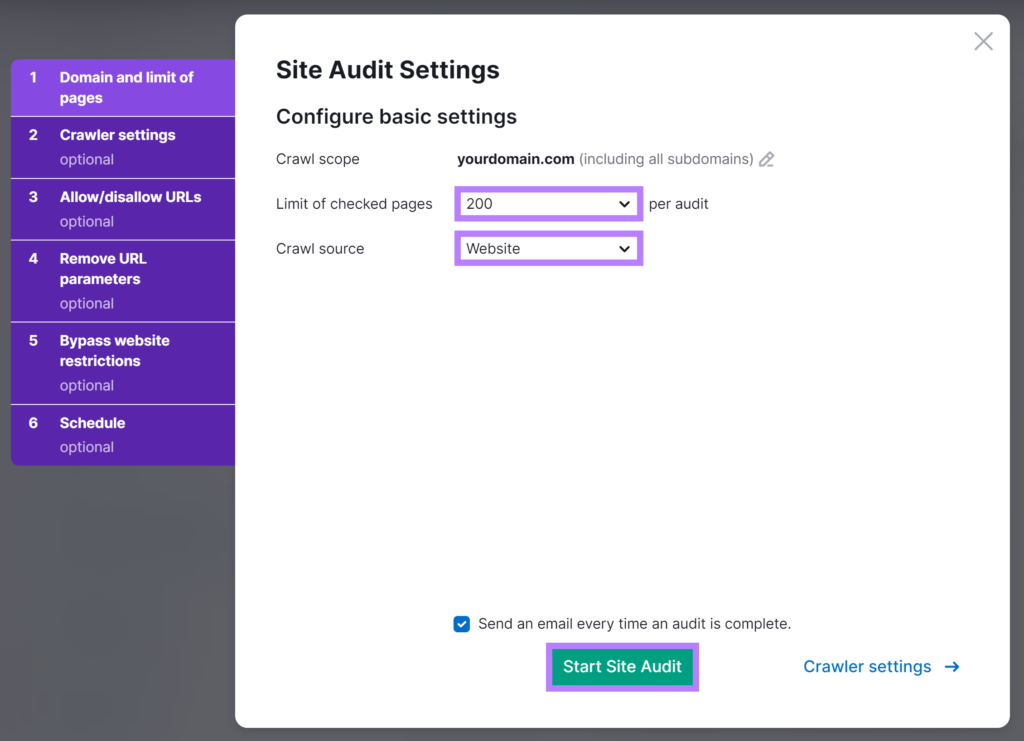
When the audit is complete, you’ll see some high-level results. Like your “Site Health” score and the total number of issues affecting your site.
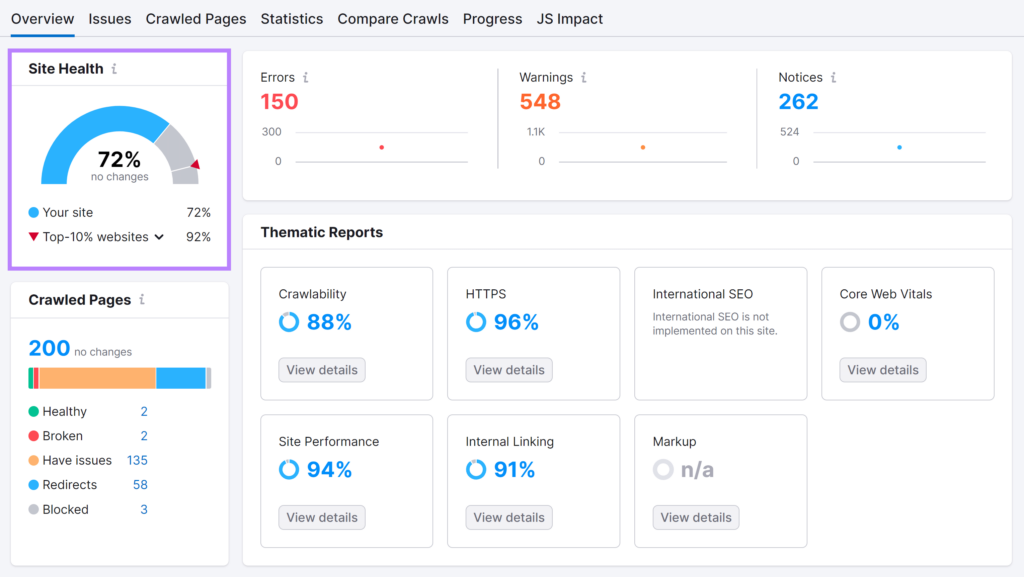
To view problems that need to be addressed, scroll down the page to “Top Issues” and click “View details.”

This will automatically open the “Issues” tab.
“Errors” are issues of the highest severity, “Warnings” are issues of medium severity, and “Notices” are non-critical items that are still worth fixing.
Click “Errors,” “Warnings,” and “Notices” in the menu bar above the list to filter for each.
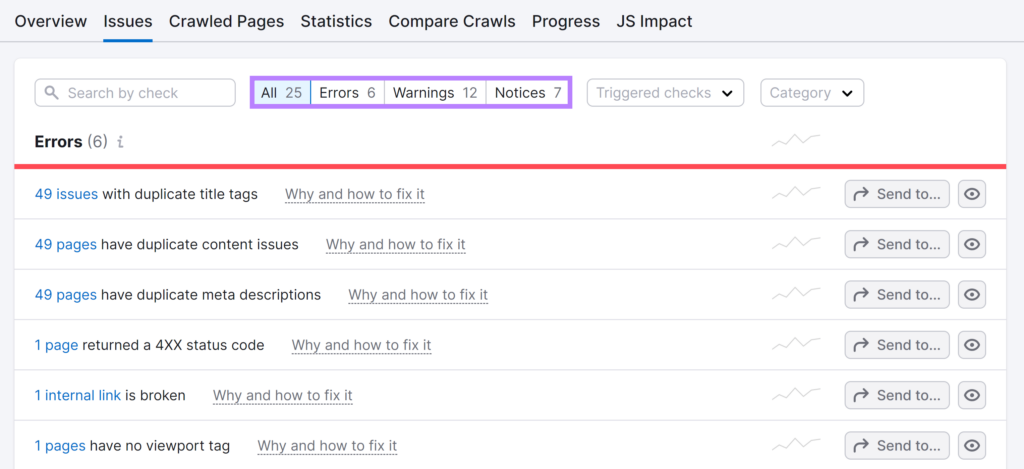
For specific instructions on how to fix a given issue, click “Why and how to fix it.” A dialogue box with more details and specific instructions will open.
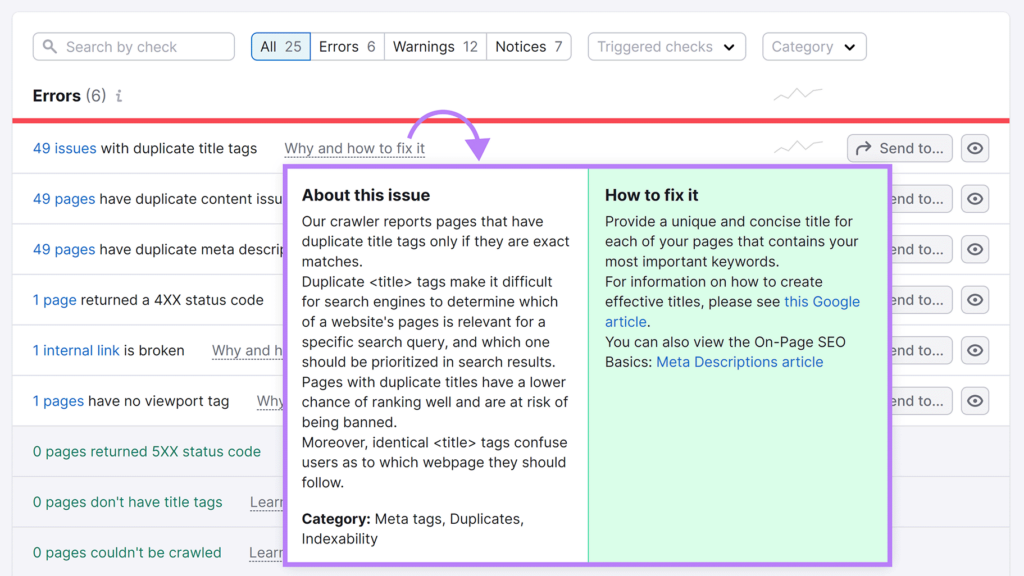
Implement these suggestions to improve your site’s chances of ranking well.
Content Audit
Auditing your content helps you find poor-performing pages that can be improved to achieve better results.
To find these pages, log in to Google Analytics.
Go to “Reports” > “Life cycle” > “Engagement” > “Pages and screens.”
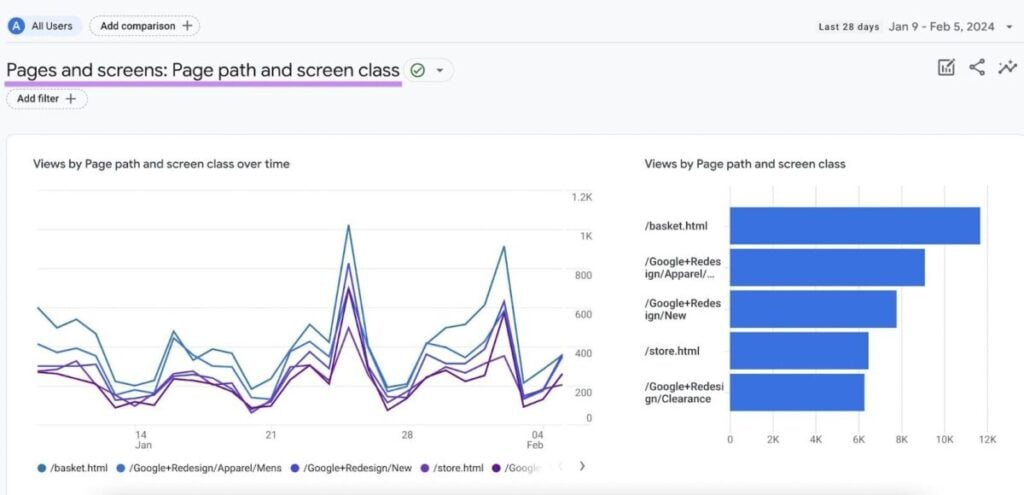
Scroll down to see a table listing your pages and a variety of metrics for each.
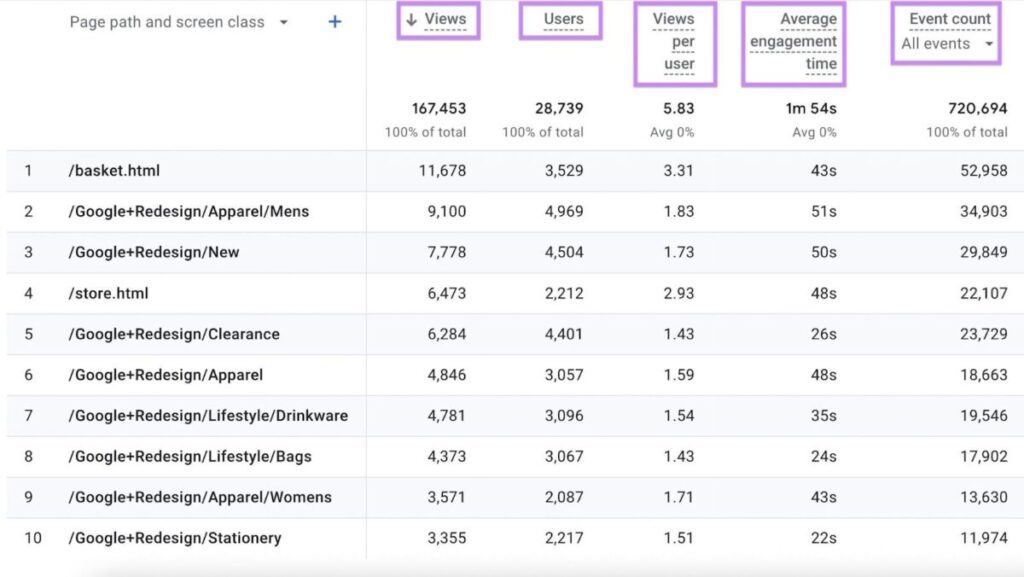
Click the arrow next to “Views” to sort the list by pages with the least visits.
Consider each of these pages and how important they are. Depending on the page, you might want to delete it, optimize it, or redirect it to a similar (and better) page on your site.
And note what you plan to do for each low-performing page.
Backlink Audit
Semrush’s Backlink Audit tool specifically focuses on auditing your site's backlinks to help you understand how healthy your backlink profile is.
Launch the tool and enter your domain in the search bar. And click “Start Backlink Audit.”

You’ll be prompted to enter your backlink audit settings. Once you’re ready, click “Start Backlink Audit.”
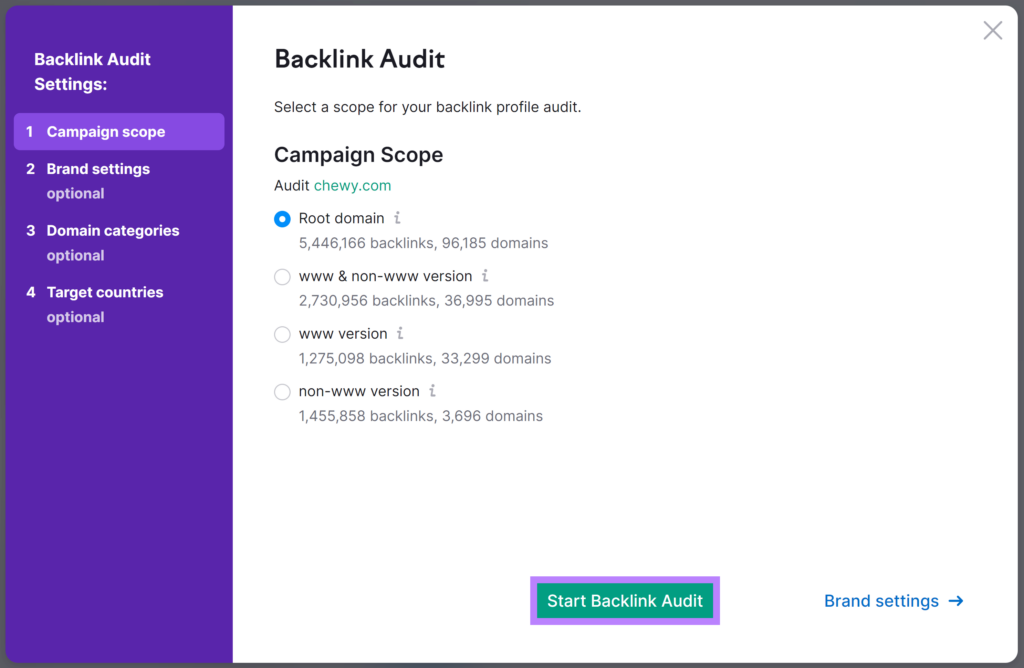
Go to the “Overview” tab to see your site’s “Toxicity Score.”
A score of “High” or “Medium” suggests that there’s quite a bit of room for improvement.
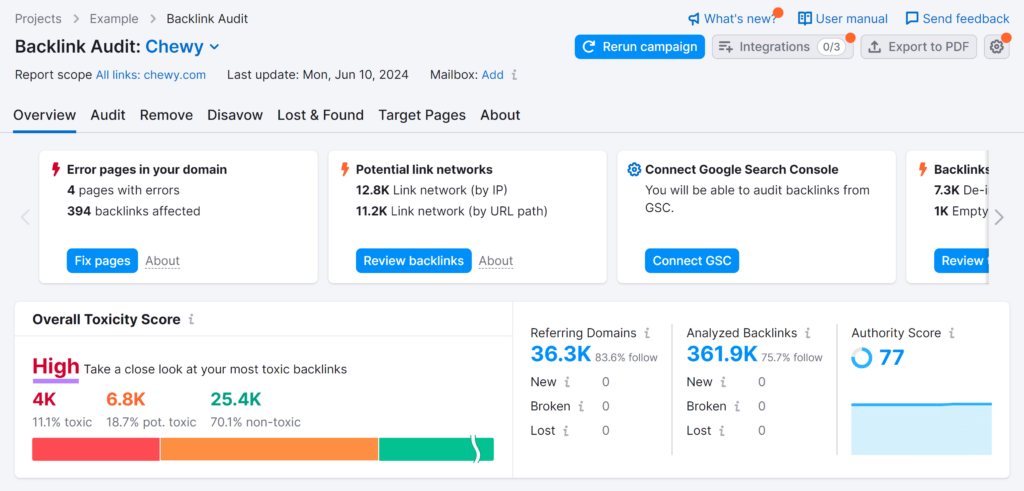
You don’t need to worry too much about having toxic backlinks in your profile. Because Google is pretty good at ignoring low-quality links.
It’s only important to address them if you’ve knowingly acquired links through questionable tactics and received a manual action penalty via Google Search Console.
Which you can check here:
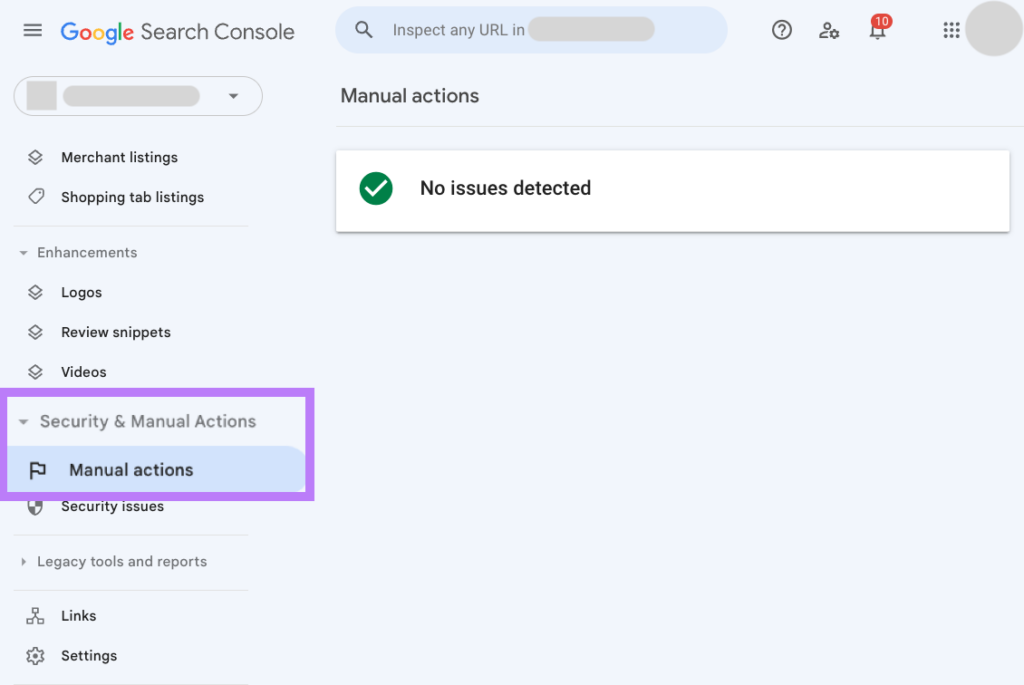
Otherwise, it’s more important to focus on building relevant, high-quality backlinks going forward.
6. Create a Content Plan
Your content plan determines what you’ll publish, when you’ll publish it, and where you’ll publish it. And you should build your content plan based on your keyword research, competitive analysis, and audit results.
Start by going to Semrush’s Keyword Strategy Builder and entering up to five of the terms you discovered during your keyword and competitive research. And click “Create list.”
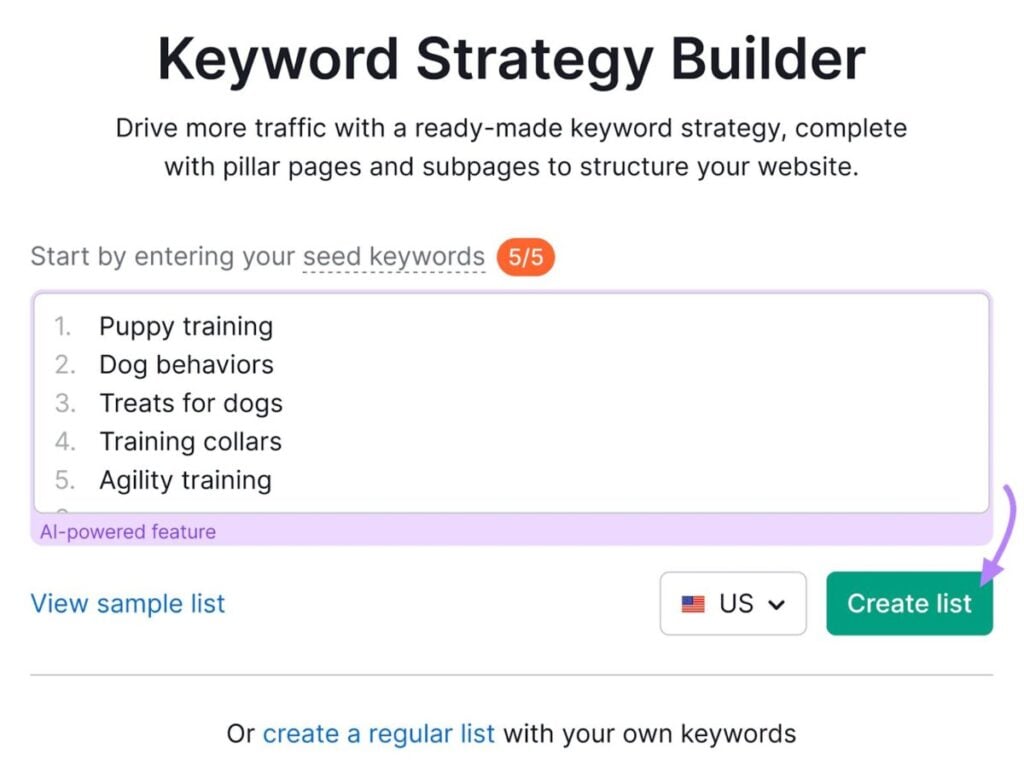
The AI-powered tool will then generate topic clusters—groups of thematically related pages that each consist of a pillar (main) page and subpages that cover specific topics in greater detail. Along with keyword clusters—groups of keywords that share the same intent and can be targeted on the same pillar page or subpage.
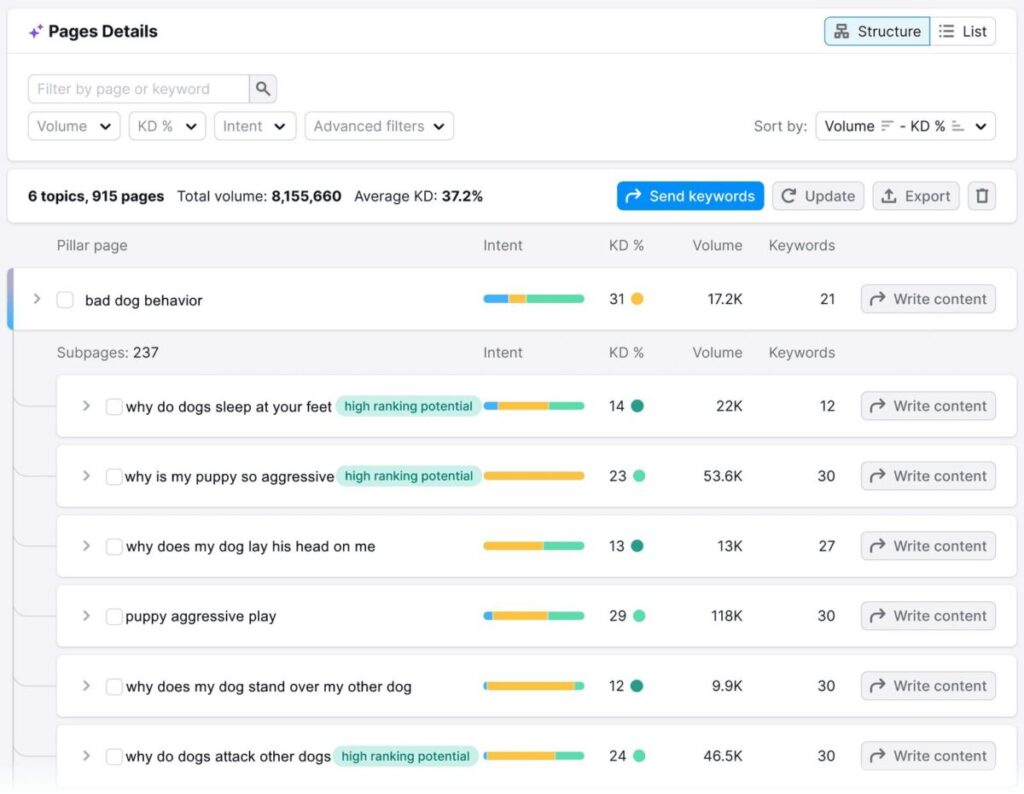
And you can view any page’s keyword cluster by clicking the gray arrow.
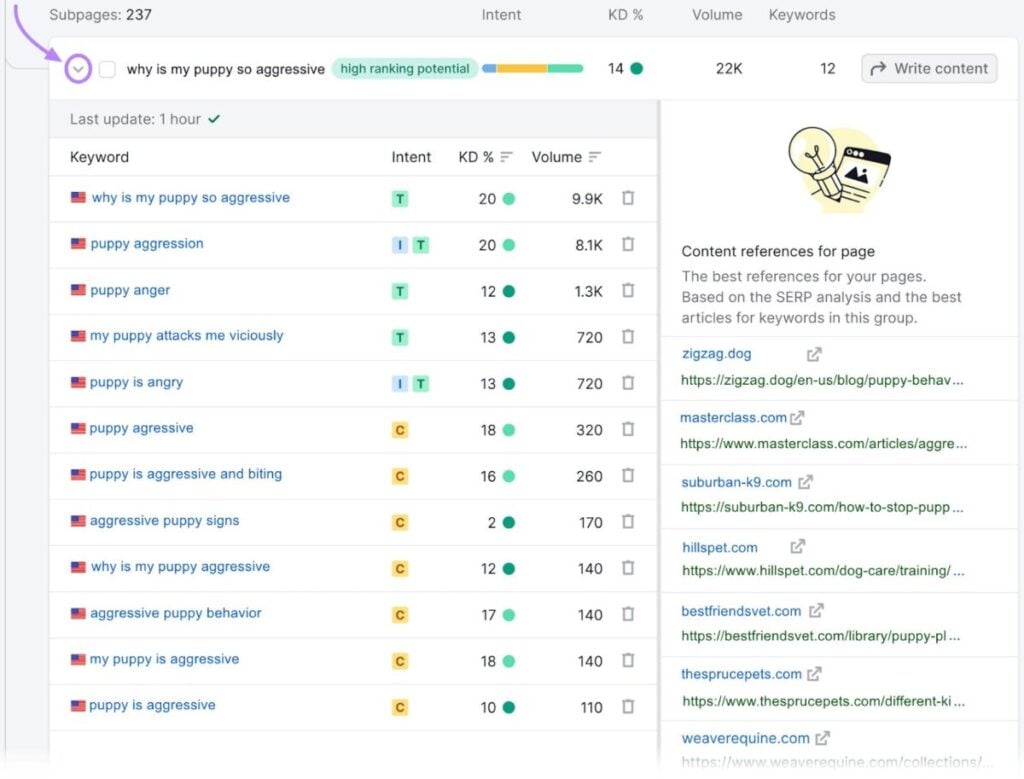
You may get a lot of results, so prioritize which pillar pages and subpages to create based on your goals and KPIs.
So if organic traffic is a KPI, it’s a good idea to focus on creating pages centered around keywords with high search volumes and relatively low keyword difficulty scores. Which the tool singles out with the “high ranking potential” tag.
Now, you’ll want to determine what content you need to create to rank by looking at the SERPs for those target keywords.
In this case, there are two main types of content—videos and written how-to guides. So, you’ll likely need something similar to achieve a high position on the SERP.
You’ll also want to organize your ideas into a content calendar. Here’s an example:

7. Find Link Building Opportunities
Acquiring backlinks from reputable sites in your industry is a great way to improve your website’s authority. So make sure you choose the right targets.
Note: It’s normal to accrue nofollow links and low-quality website backlinks, but they’re not worth pursuing.
One of the best ways to quickly determine which backlinks to pursue is by analyzing who links to your competitors but not to you.
Do that with Semrush’s Backlink Gap tool.
Enter your domain into the “You” field. Then, add your competitors (up to four) and click “Find prospects.”
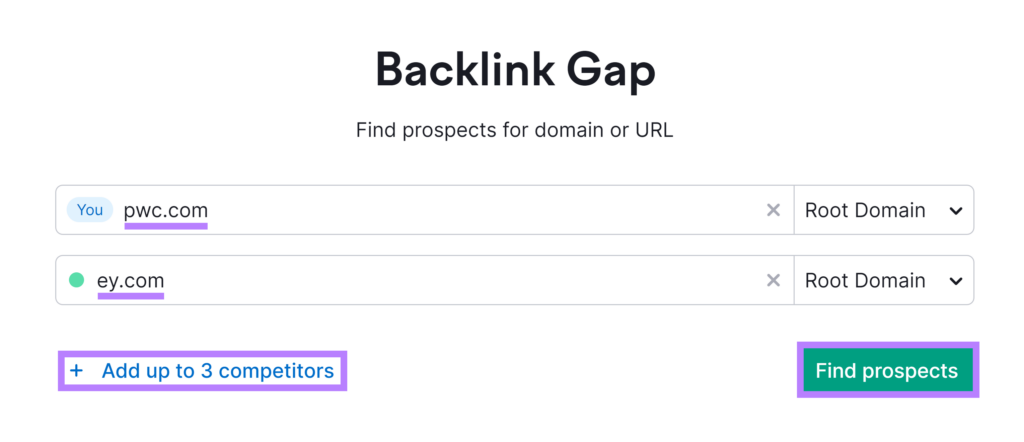
You’ll see a list of the “Best” domains to target. They point to all of your competitors but not to you.
Select “Weak” to see domains that point to you less than to your competitors. “
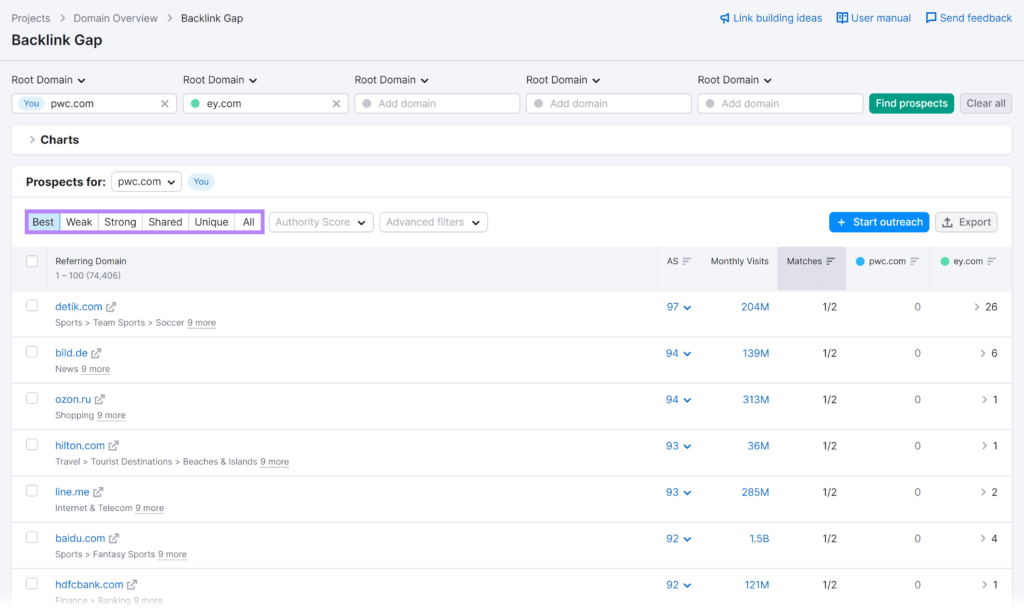
When you find a handful of websites you want to contact to request backlinks, check the box next to them, and click “+ Start outreach” in the upper right corner.
You’ll be prompted to send your target domains to Semrush’s Link Building Tool. After you choose the correct project, click “Go to Link Building tool” in the dialogue box that appears.
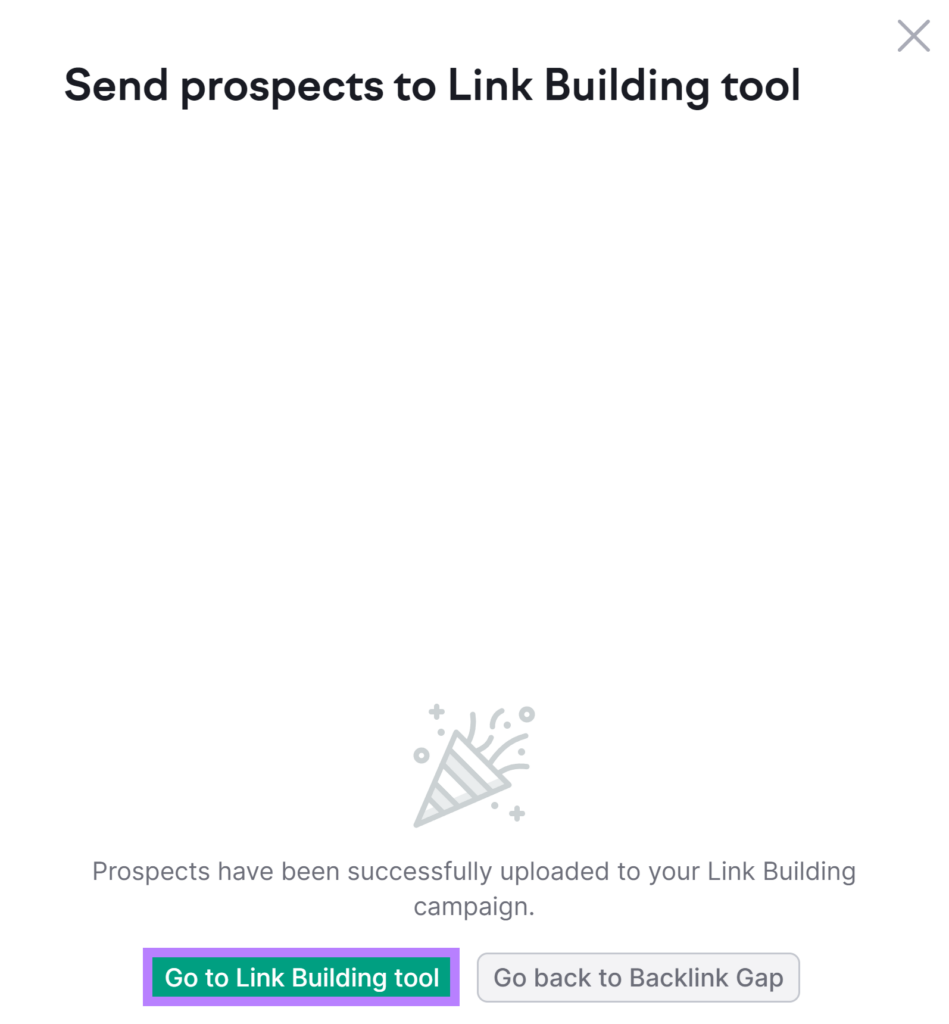
You’ll then see the “Overview” tab, which offers a visual representation of all your domain prospects and where they came from.
Click “Go to Prospects” to see your entire list.
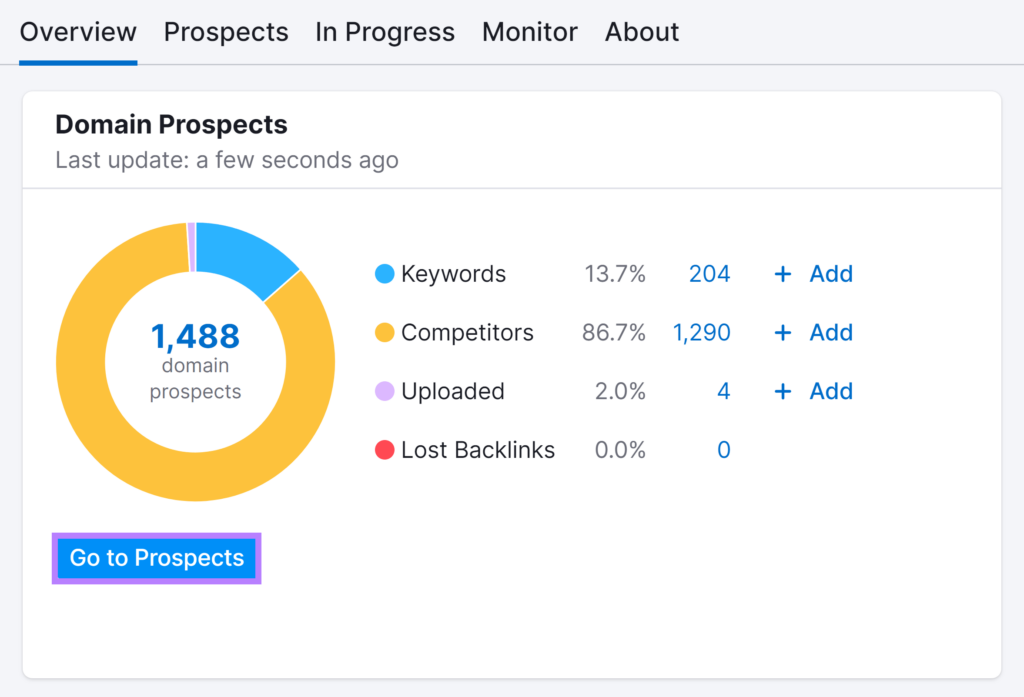
Click the box next to the domain names you want to reach out to and select “To In Progress.”
Then, select the “In Progress” tab to start outreach.

Click “Contact” next to a domain you want to reach.
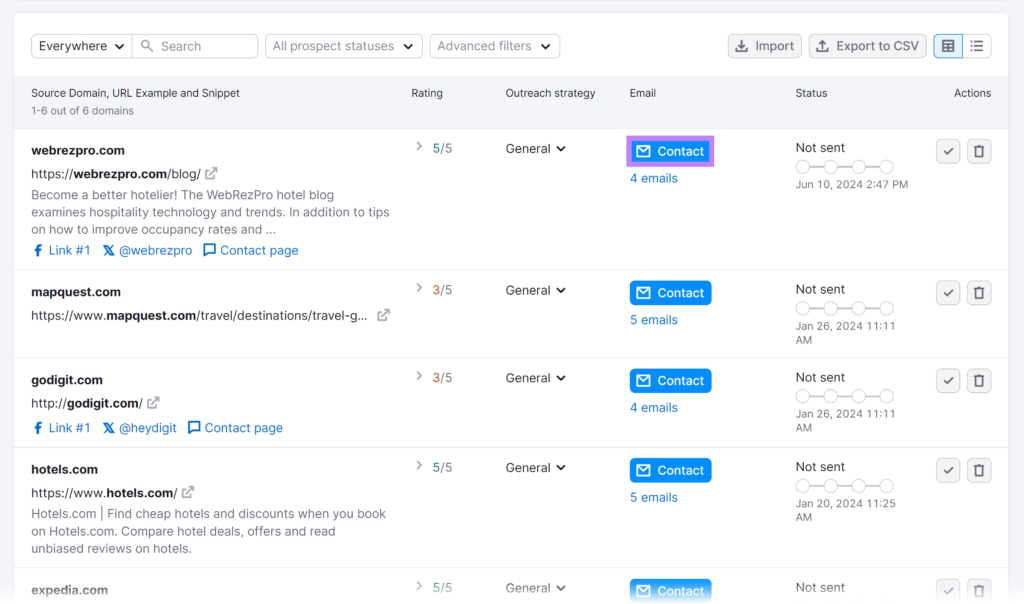
Now, draft a personalized email asking for a backlink. Which is typically easiest when you’re able to share a piece of relevant content the contact is likely to find useful.
Click “Send and proceed to next” to send your email and move to the next one.
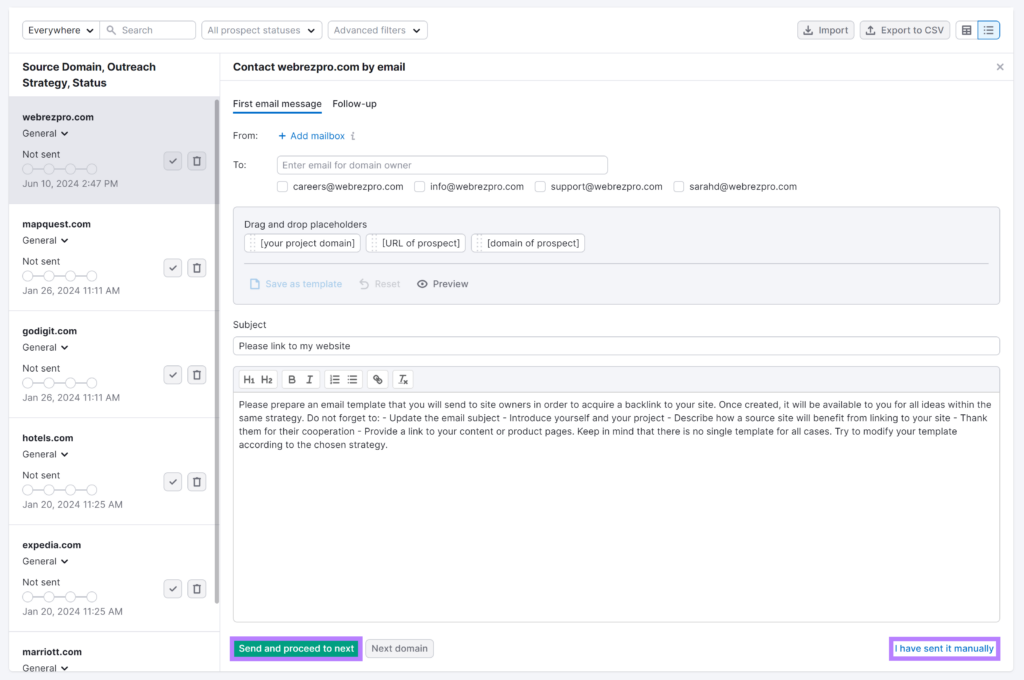
8. Document Your SEO Strategy
Keeping your SEO strategy and progress documented in one place keeps you organized. It also helps you communicate information to your team as you go.
Semrush’s free SEO template provides a good starting point. And you can adjust it based on your needs.
You can even use the template to build topic clusters or groups of content to target a set of keywords, track technical and on-page SEO tasks, and more.
Boost Your Rankings with an Effective SEO Strategy
Building an effective SEO strategy isn’t just about creating content to rank for keywords. It’s about finding the opportunities that will make the most impact on your specific goals.
Semrush’s suite of tools can help:
- Keyword Magic Tool: Uncover keyword opportunities
- Keyword Gap: Identify terms that your competitors are ranking for but you aren’t
- Organic Research: Analyze your competitors’ top-performing pages and strategies
- Backlink Analytics: Assess the quality of your backlink profile
- Backlink Gap: Discover backlink opportunities by comparing your profile with your competitors’ profiles
Get all these tools and more with a free Semrush trial.
Frequently Asked Questions
Does SEO still work in 2024?
Yes, SEO is still very much relevant in 2024 as search engines still need to crawl and categorize web pages to rank them, and SEO is necessary to help them do so.
How much does SEO cost in 2024?
The cost of SEO depends on a number of factors such as the size of your business, the scope of the project, and the agency you’re working with. Generally, you can expect to spend anywhere between $1,500 and $7,500 per month on SEO.
How to rank on Google in 2024?
Creating high-quality content, getting quality backlinks, improving your website structure, and improving your site load speed are some of the basic steps to rank on Google in 2024.
Is SEO dead due to AI?
AI will change the SEO landscape, but won’t render it completely obsolete.
What is bad for SEO?
Thin content, poorly written content, duplicate content, technical SEO issues, failing to match search intent, etc. are some of the worst things for your site’s SEO.


